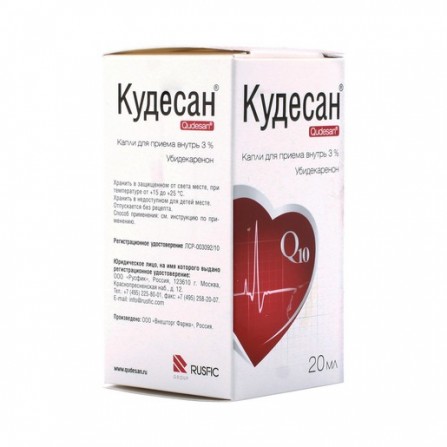Kudesang solution vial-drops 3% 20ml
Condition: New product
999 Items
Rating:
Be the first to write a review!

More info
Active ingredients
Ubidekarenon
The brand
Kudesang
Release form
Solution
Composition
Active ingredient: Ubidekarenone (Ubidecarenone) Concentration of active ingredient (mg): 30
Pharmacological effect
A drug that normalizes myocardial metabolism, which reduces tissue hypoxia. Ubidekarenone (coenzyme Q10, ubiquinone) is a natural substance that is a vitamin-like coenzyme. Ubidecarenone is an endogenous substrate, takes part in the transfer of electrons in the transport chain of redox processes, in the process of energy exchange, in the reaction of oxidative phosphorylation in the respiratory chain of mitochondria of cells. Participates in the processes of cellular respiration, increasing the synthesis of ATP. It has a clinically significant antioxidant effect. Protects cell membrane lipids from peroxidation. Reduces the area of myocardial damage under ischemia and reperfusion. Ubidekarenone prevents prolongation of the QT interval, improves exercise tolerance. Due to the endogenous synthesis, 100% satisfaction of the body's need for coenzyme Q10 occurs only up to the age of 20. The concentration of coenzyme Q10 is reduced in elderly patients, as well as in various diseases in both adults and children.
Pharmacokinetics
Data on the pharmacokinetics of the drug is not provided.
Indications
Adults: For prophylaxis and as part of the complex treatment of various diseases of the cardiovascular system: - chronic heart failure - dilated cardiomyopathy - ischemic heart disease, including myocardial infarction (during rehabilitation), - arrhythmias, - arterial hypertension, - preparation period for cardiac surgery (coronary artery bypass surgery, for heart defects). Children (from 1 year): For prophylaxis and as part of complex therapy: diseases of the cardiovascular system: - arrhythmias, - chronic heart failure, - dilated cardiomyopathy, - preparation period for cardiac surgery (congenital and acquired defects), diseases of the gastrointestinal tract: - chronic gastroduodenitis, kidney diseases: - chronic pyelonephritis, - metabolic nephropathy, diseases of the nervous system (including hereditary neurodegenerative diseases): - migraine, - disorders of the autonomic nervous system (neuro-circulatory dystonia), - mitochondrial encephalomyopathy (MELAS syndrome), Leiga syndrome, - tuberous SC eroz - congenital myopathymuscular dystrophies. In complex therapy of diseases associated with metabolic disorders: - asthenic syndrome - recovery period after serious diseases and surgical interventions. Adults and children (from 1 year): - for the prevention and replenishment of coenzyme Q10 deficiency - to improve adaptation to increased physical exertion from athletes.
Contraindications
Hypersensitivity to the drug. Children's age up to 1 year.
Precautionary measures
Do not exceed recommended doses.
Use during pregnancy and lactation
The drug is not recommended to prescribe during pregnancy and during breastfeeding due to the lack of sufficient experience of clinical use.
Dosage and administration
Adults and children over 14 years old, 10-11 drops (0.5 ml) 1 time per day with meals, after having been dissolved in a small amount of water or another drink. Before use, it is recommended to consult a doctor.
Side effects
Allergic reactions are possible. Very rarely: nausea, diarrhea.
Overdose
Cases of drug overdose Kudesan was not observed.
Interaction with other drugs
Simultaneous use of lipid-lowering drugs (statins, fibrates), beta-blockers (atenolol, metoprolol, propranolol), tricyclic antidepressants can lead to a decrease in the concentration of ubidecarenone in the blood plasma. .
special instructions
Before starting hormonal contraception and every 6 months thereafter, a general medical and gynecological examination is recommended, including a cytological analysis of a smear from the cervix, assessment of the mammary glands, determination of blood glucose, cholesterol and other indicators of liver function, blood pressure control, urinalysis. Purpose Rigevidone is not recommended for women with thromboembolic diseases at a young age and increased blood clotting in the family history. The use of oral contraceptive dopa is reported no earlier than 6 months after suffering viral hepatitis, provided that the liver functions normally. If severe pain occurs in the upper abdomen, hepatomegaly and signs of intra-abdominal bleeding, a liver tumor may be suspected.If necessary, taking the drug should be discontinued. In case of liver dysfunction while taking Rigevidon, consultation of the therapist is necessary. If there is acyclic (intermenstrual) bleeding, Rigevedon should be continued because in most cases, these bleedings stop spontaneously. If acyclic (intermenstrual) bleeding does not disappear or recur, a medical examination should be conducted to exclude organic pathology of the reproductive system. In case of vomiting or diarrhea, the drug should be continued using another non-hormonal method of contraception. Smokers who take hormonal contraceptives have an increased risk. development of cardiovascular diseases with serious consequences (myocardial infarction, stroke). The risk increases with age and depending on the number of cigarettes smoked (especially for women older than 35 years). The drug should be stopped in the following cases: - when a first appearance or increase of migraine-like headache; - when an unusually strong headache appears; - when an early signs of phlebitis or phlebothrombosis (unusual pain or bloating of the veins in the legs); - in the event of jaundice or hepatitis without jaundice; - in cerebrovascular disorders; - in the event of stitching pains of unclear etiology during breathing or and cough, pain and feeling of tightness in the chest; - with acute deterioration of visual acuity; - with suspected thrombosis or heart attack; - with a sharp increase in blood pressure; - with the occurrence of generalized itching; - with an increase in epileptic seizures; - 3 months before the planned pregnancy; - approximately 6 weeks before the planned surgical intervention; - with prolonged immobilization; - with the onset of pregnancy. Influence on the ability to drive vehicles and control mechanisms. The drug does not affect the ability to drive tra Sportna funds and the management of other mechanisms, the work that is associated with an increased risk of injury.






